Projects
Basic research
The Neurovascular Research Laboratory's basic research primarily focuses on better understanding the mechanisms of aneurysm growth and rupture and the healing of aneurysms. New therapeutic approaches for treating intracranial saccular aneurysms also are being researched, including some under good laboratory practice (GLP) standards — the most stringent preclinical testing conditions approved by the U.S. Food and Drug Administration (FDA).
1. Animal modeling of aneurysms
The Neurovascular Research Lab has developed an animal model of intracranial saccular aneurysms at the right common carotid artery in rabbits. This elastase model of saccular aneurysm has been widely applied as a preclinical example to test endovascular devices and is routinely accepted by the FDA. Several endovascular devices that are commercially available have been tested this way, as the rabbit aneurysm is similar to the human aneurysm histologically and morphologically. In addition, this model shares many molecular and hemodynamic features with human intracranial aneurysms.
The rabbit elastase model has achieved widespread application with advantages. These include:
- A curved vessel anatomy that simulates human aneurysms, such as those in the ophthalmic region.
- Demonstrated long-term patency.
- Aneurysm sizes similar to the mean size of human aneurysms.
Histopathologic studies show that after embolization with platinum coils, the lab's model mimics the healing seen in human aneurysms. This preclinical model is ideally suited for studying endovascular devices for aneurysm treatment and aneurysm growth.
The lab continues to improve the animal modeling of aneurysms that are more relevant to human intracranial aneurysms through continued development and testing.
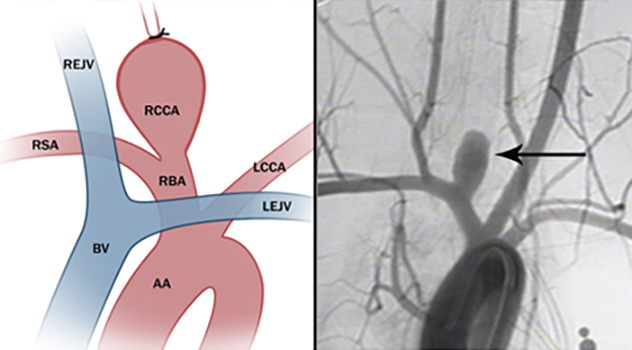
At left is the schematic representation of aneurysmal enlargement of the proximal right common carotid artery after distal ligation and elastase injury. At right is a digital subtraction angiography showing aneurysm cavity.
2. Improving treatment of aneurysms
A noninvasive and reliable form of treatment has yet to be discovered for the clinical management of intracranial saccular aneurysms. The lab aims to improve existing methods of minimally invasive treatments, such as flow diverters or microcoils, while also exploring alternative nonendovascular procedures. To improve the stabilization and healing process after treatment, systemic therapies using disease modifiers, local delivery of proteins and stem cells, and bioresorbable devices also are being tested.
These discoveries increase understanding of the mechanisms involved in the healing process and benefit patients who have intracranial aneurysms. The long-term goal is to reduce or remove the risk of aneurysm rupture.
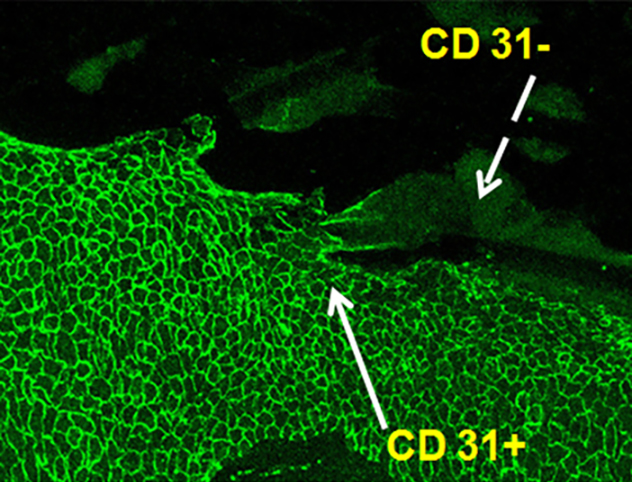
Immunostained confocal microscopic image of a tissue island at the neck of the aneurysm with a cluster of differentiation 31 (CD31) stain (forward-facing, original 20 times magnification). Note the confluent coverage with CD31-positive endothelial cells along more peripherally located struts (solid arrow) in direct contiguity with parent artery, with a well-demarcated interface between CD31-positive and CD31-negative (dashed arrow) cells covering more centrally located struts.
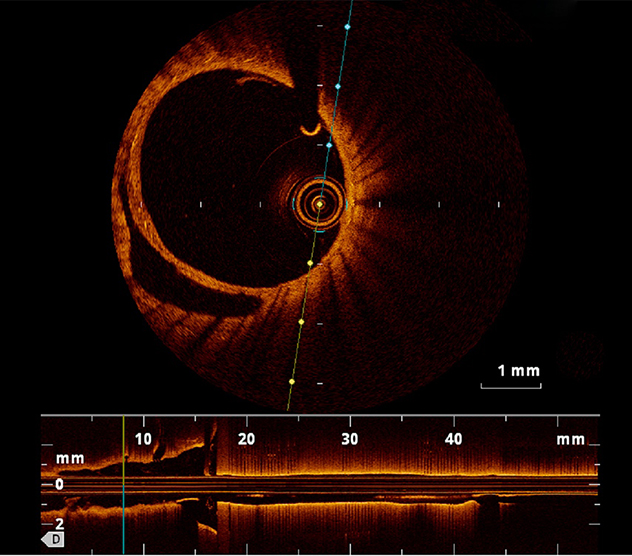
Optical coherence tomography (OCT), a high-resolution cross-sectional imaging technology, is used to picture an aneurysm from within the artery.
3. Computational fluid dynamics and particle image velocimetry of brain aneurysms
Given the high mortality rate associated with ruptured intracranial aneurysms, determining the risk of rupture is critical to management decisions. Advanced imaging techniques available today enable healthcare professionals to view the blood flow through arteries but do not provide meaningful quantitative assessment of in vivo hemodynamics. Computational fluid dynamics studies can identify various physical flow phenomena that have been implicated in causing rupture.
The purpose of this research is to find correlations between hemodynamic variables and clinical events to better understand aneurysm development and improve patient evaluation and treatment. In collaboration with Mayo Clinic's Division of Engineering, the lab is using particle image velocimetry to validate companion computational fluid dynamics simulations on patient-specific aneurysm models. These data also are being used in experiments to compare fluid mechanics behavior in aneurysms treated with different therapeutic devices.
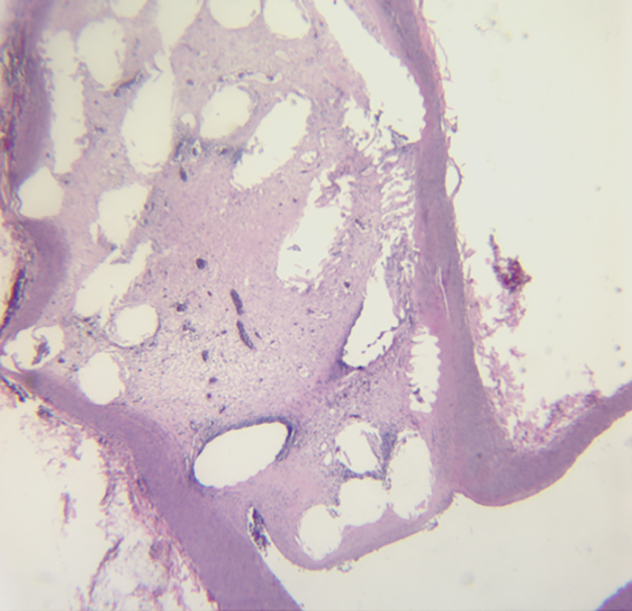
Platinum coil-bearing tissues are processed via paraffin embedding. This technique secures good preservation of morphology, as well as multiple, thin sections that are easily stained with standard and advanced histological staining techniques. Photomicrograph shows unorganized thrombus within the aneurysm cavity and across the aneurysm neck. Excellent tissue preservation was achieved in this setting of friable thrombus (hematoxylin and eosin stain, original 20 times magnification).
4. Stroke Thromboembolism Registry of Imaging and Pathology (STRIP)
With the arrival of mechanical thrombectomy to treat acute ischemic stroke, interest is growing around the histopathological and imaging characteristics of retrieved blood clots, termed thromboemboli. Past studies show that clot composition can provide insights into stroke etiology and demonstrate association of recanalization success with IV thrombolysis and mechanical thrombectomy. Furthermore, improved characterization of clot composition regarding imaging and histopathologic features could help in device selection prior to the mechanical thrombectomy procedure itself.
STRIP is a multicenter project that aims to:
- Characterize the histopathologic features of thromboemboli of various etiologies using a combination of histology — hematoxylin and eosin, and Martius scarlet blue — and immunostaining methods.
- Examine the correlation between clot composition and degree and ease of revascularization using mechanical thrombectomy techniques.
- Review the association between:
- Device selection — aspiration versus stent retriever.
- Technique selection — balloon guide catheter versus standard catheter.
- Clot subtype — RBC-rich, platelet-rich, fibrin-rich, WBC-rich.
- Angiographic outcomes.
- Investigate the association between the presence of a hyperdense artery sign found during imaging, and clot histological characteristics.
- Study the mechanism of resistance to thrombolysis.
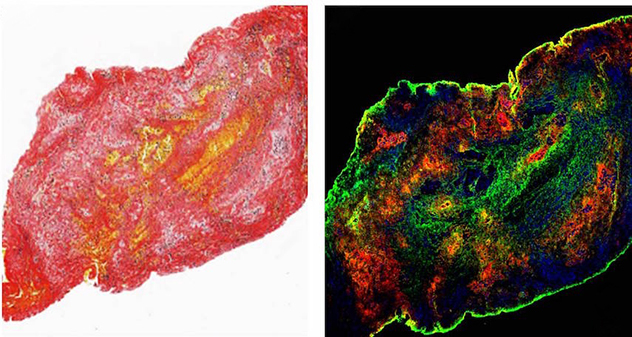
At left is an example of an acute ischemic stroke clot stained with Martius scarlet blue stain. At right is a confocal image demonstrating the presence of platelets (red), fibrinogen (green) and white blood cells (blue).
5. Clinical trials
The Neurovascular Research Laboratory has been involved in numerous clinical trials related to cerebral aneurysm and thrombectomy devices.